Supply Chain Management Practices Analysis Report - Business
VerifiedAdded on 2021/06/14
|13
|3469
|82
Report
AI Summary
This report provides an in-depth analysis of supply chain management (SCM) practices, emphasizing their critical role in achieving organizational success and competitive advantage in the globalized market. The report begins by defining supply chain mapping, a strategy used to reduce waste and improve performance by visualizing the flow of information and materials. It discusses the importance of understanding the supply chain, identifying bottlenecks, and eliminating non-value-added activities. The report then explores the implications of a good SCM practice, highlighting the importance of strategic supplier partnerships, customer relationships, information sharing, and postponement strategies. It emphasizes the factors influencing the development of effective supply chains, including production, inventory management, and transportation. The analysis also covers how effective SCM contributes to competitive advantages through cost reduction, time-to-market improvements, quality products, and dependable delivery systems. The report concludes by underscoring the significance of SCM in the modern competitive environment, where organizational performance relies on the integration of internal and external business processes and the ability to adapt to changing market dynamics.
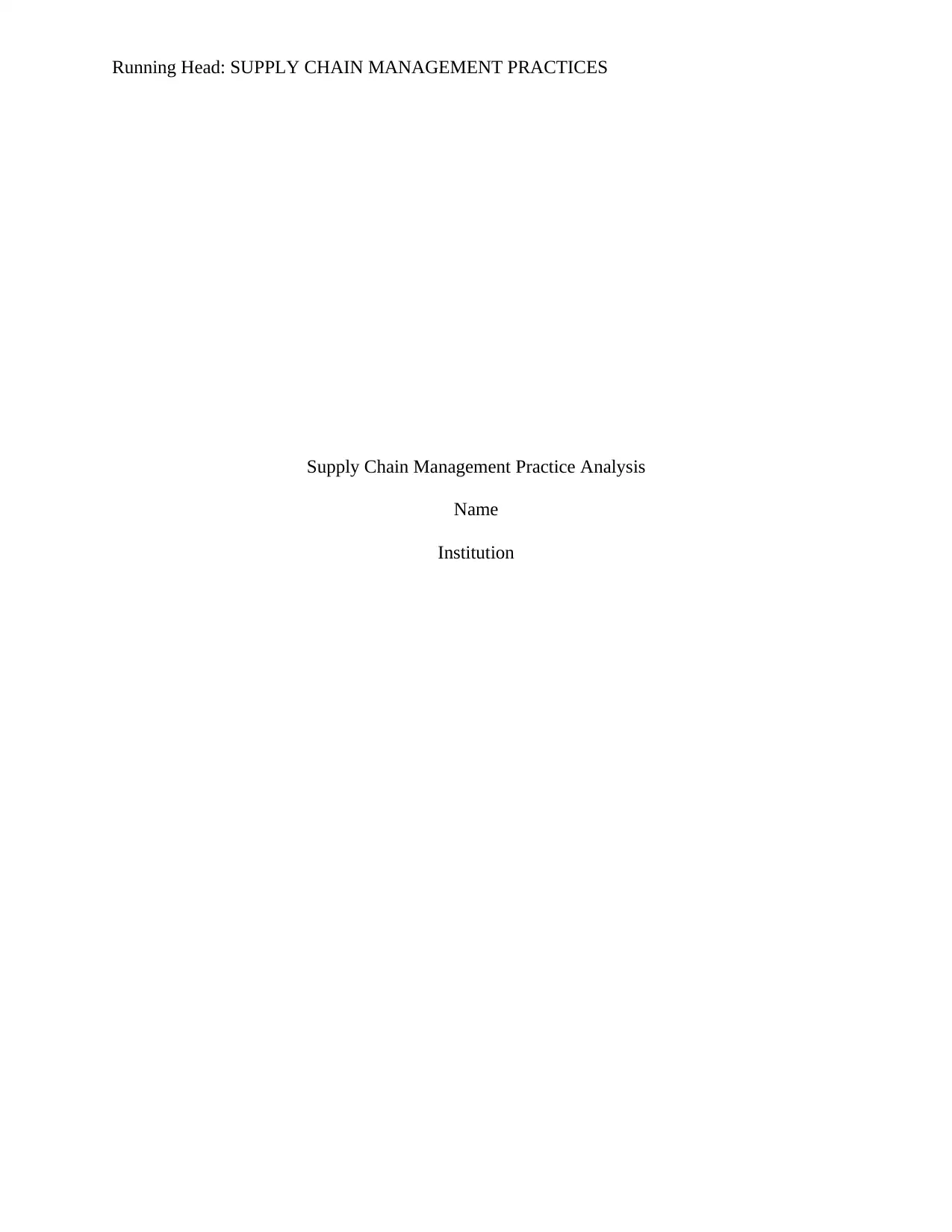
Running Head: SUPPLY CHAIN MANAGEMENT PRACTICES
Supply Chain Management Practice Analysis
Name
Institution
Supply Chain Management Practice Analysis
Name
Institution
Paraphrase This Document
Need a fresh take? Get an instant paraphrase of this document with our AI Paraphraser
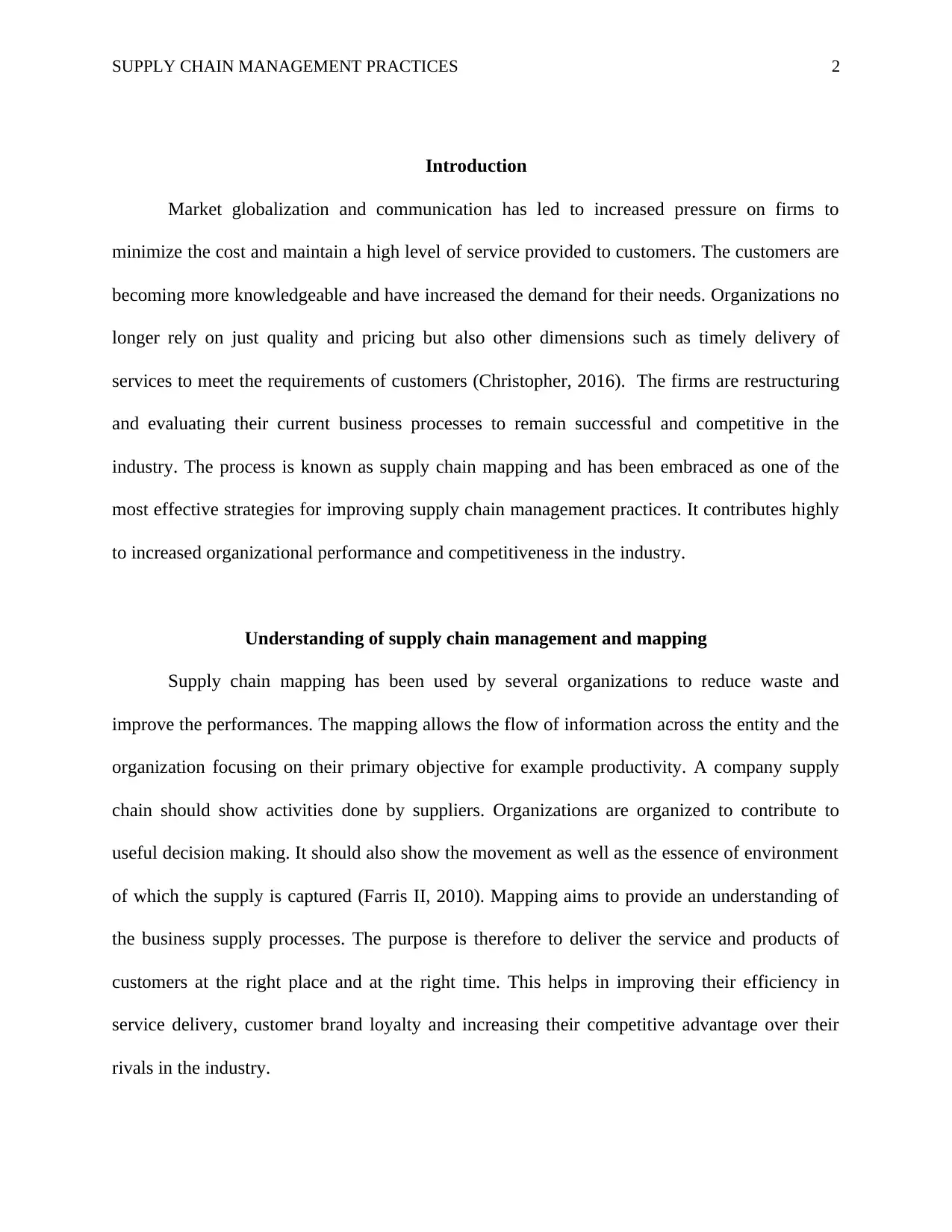
SUPPLY CHAIN MANAGEMENT PRACTICES 2
Introduction
Market globalization and communication has led to increased pressure on firms to
minimize the cost and maintain a high level of service provided to customers. The customers are
becoming more knowledgeable and have increased the demand for their needs. Organizations no
longer rely on just quality and pricing but also other dimensions such as timely delivery of
services to meet the requirements of customers (Christopher, 2016). The firms are restructuring
and evaluating their current business processes to remain successful and competitive in the
industry. The process is known as supply chain mapping and has been embraced as one of the
most effective strategies for improving supply chain management practices. It contributes highly
to increased organizational performance and competitiveness in the industry.
Understanding of supply chain management and mapping
Supply chain mapping has been used by several organizations to reduce waste and
improve the performances. The mapping allows the flow of information across the entity and the
organization focusing on their primary objective for example productivity. A company supply
chain should show activities done by suppliers. Organizations are organized to contribute to
useful decision making. It should also show the movement as well as the essence of environment
of which the supply is captured (Farris II, 2010). Mapping aims to provide an understanding of
the business supply processes. The purpose is therefore to deliver the service and products of
customers at the right place and at the right time. This helps in improving their efficiency in
service delivery, customer brand loyalty and increasing their competitive advantage over their
rivals in the industry.
Introduction
Market globalization and communication has led to increased pressure on firms to
minimize the cost and maintain a high level of service provided to customers. The customers are
becoming more knowledgeable and have increased the demand for their needs. Organizations no
longer rely on just quality and pricing but also other dimensions such as timely delivery of
services to meet the requirements of customers (Christopher, 2016). The firms are restructuring
and evaluating their current business processes to remain successful and competitive in the
industry. The process is known as supply chain mapping and has been embraced as one of the
most effective strategies for improving supply chain management practices. It contributes highly
to increased organizational performance and competitiveness in the industry.
Understanding of supply chain management and mapping
Supply chain mapping has been used by several organizations to reduce waste and
improve the performances. The mapping allows the flow of information across the entity and the
organization focusing on their primary objective for example productivity. A company supply
chain should show activities done by suppliers. Organizations are organized to contribute to
useful decision making. It should also show the movement as well as the essence of environment
of which the supply is captured (Farris II, 2010). Mapping aims to provide an understanding of
the business supply processes. The purpose is therefore to deliver the service and products of
customers at the right place and at the right time. This helps in improving their efficiency in
service delivery, customer brand loyalty and increasing their competitive advantage over their
rivals in the industry.
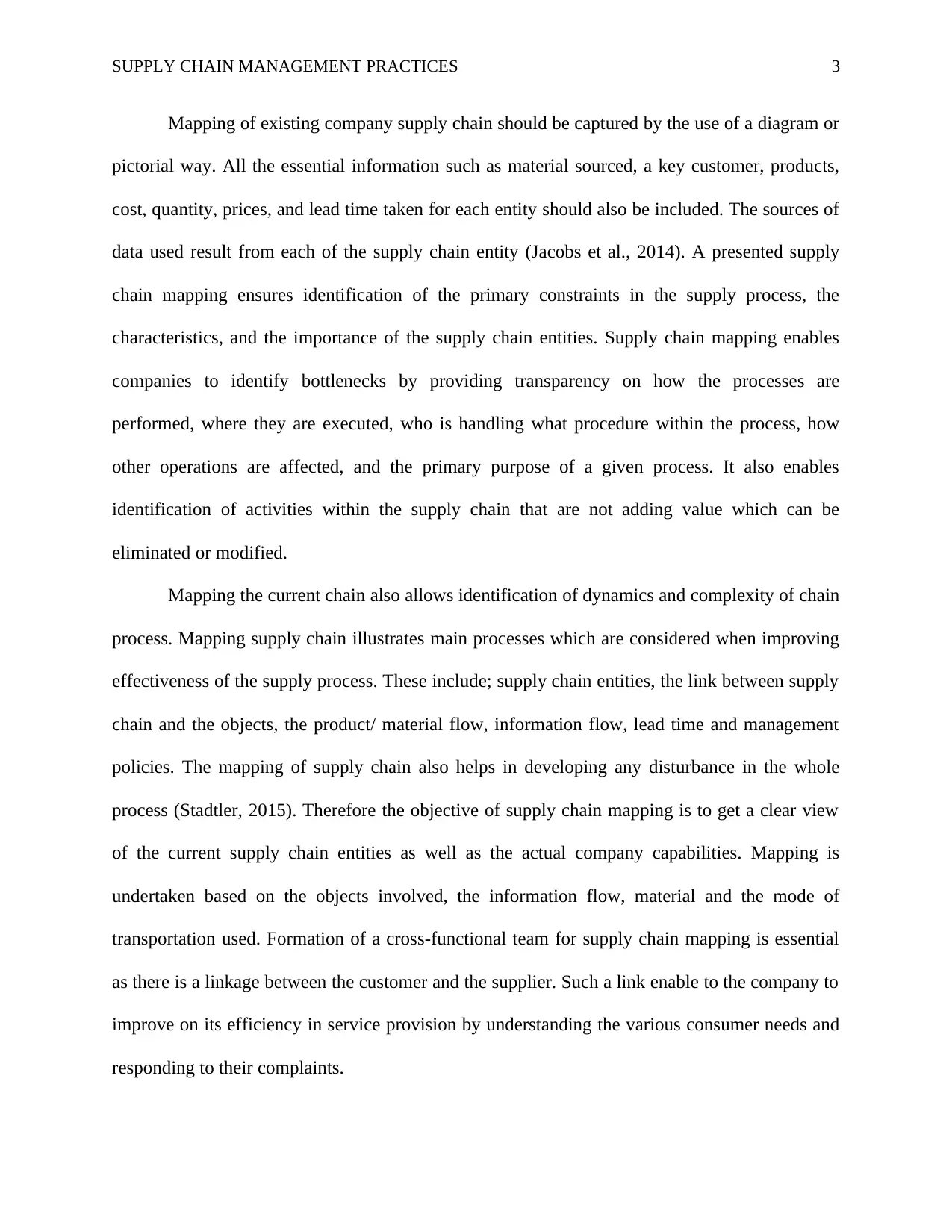
SUPPLY CHAIN MANAGEMENT PRACTICES 3
Mapping of existing company supply chain should be captured by the use of a diagram or
pictorial way. All the essential information such as material sourced, a key customer, products,
cost, quantity, prices, and lead time taken for each entity should also be included. The sources of
data used result from each of the supply chain entity (Jacobs et al., 2014). A presented supply
chain mapping ensures identification of the primary constraints in the supply process, the
characteristics, and the importance of the supply chain entities. Supply chain mapping enables
companies to identify bottlenecks by providing transparency on how the processes are
performed, where they are executed, who is handling what procedure within the process, how
other operations are affected, and the primary purpose of a given process. It also enables
identification of activities within the supply chain that are not adding value which can be
eliminated or modified.
Mapping the current chain also allows identification of dynamics and complexity of chain
process. Mapping supply chain illustrates main processes which are considered when improving
effectiveness of the supply process. These include; supply chain entities, the link between supply
chain and the objects, the product/ material flow, information flow, lead time and management
policies. The mapping of supply chain also helps in developing any disturbance in the whole
process (Stadtler, 2015). Therefore the objective of supply chain mapping is to get a clear view
of the current supply chain entities as well as the actual company capabilities. Mapping is
undertaken based on the objects involved, the information flow, material and the mode of
transportation used. Formation of a cross-functional team for supply chain mapping is essential
as there is a linkage between the customer and the supplier. Such a link enable to the company to
improve on its efficiency in service provision by understanding the various consumer needs and
responding to their complaints.
Mapping of existing company supply chain should be captured by the use of a diagram or
pictorial way. All the essential information such as material sourced, a key customer, products,
cost, quantity, prices, and lead time taken for each entity should also be included. The sources of
data used result from each of the supply chain entity (Jacobs et al., 2014). A presented supply
chain mapping ensures identification of the primary constraints in the supply process, the
characteristics, and the importance of the supply chain entities. Supply chain mapping enables
companies to identify bottlenecks by providing transparency on how the processes are
performed, where they are executed, who is handling what procedure within the process, how
other operations are affected, and the primary purpose of a given process. It also enables
identification of activities within the supply chain that are not adding value which can be
eliminated or modified.
Mapping the current chain also allows identification of dynamics and complexity of chain
process. Mapping supply chain illustrates main processes which are considered when improving
effectiveness of the supply process. These include; supply chain entities, the link between supply
chain and the objects, the product/ material flow, information flow, lead time and management
policies. The mapping of supply chain also helps in developing any disturbance in the whole
process (Stadtler, 2015). Therefore the objective of supply chain mapping is to get a clear view
of the current supply chain entities as well as the actual company capabilities. Mapping is
undertaken based on the objects involved, the information flow, material and the mode of
transportation used. Formation of a cross-functional team for supply chain mapping is essential
as there is a linkage between the customer and the supplier. Such a link enable to the company to
improve on its efficiency in service provision by understanding the various consumer needs and
responding to their complaints.
⊘ This is a preview!⊘
Do you want full access?
Subscribe today to unlock all pages.

Trusted by 1+ million students worldwide
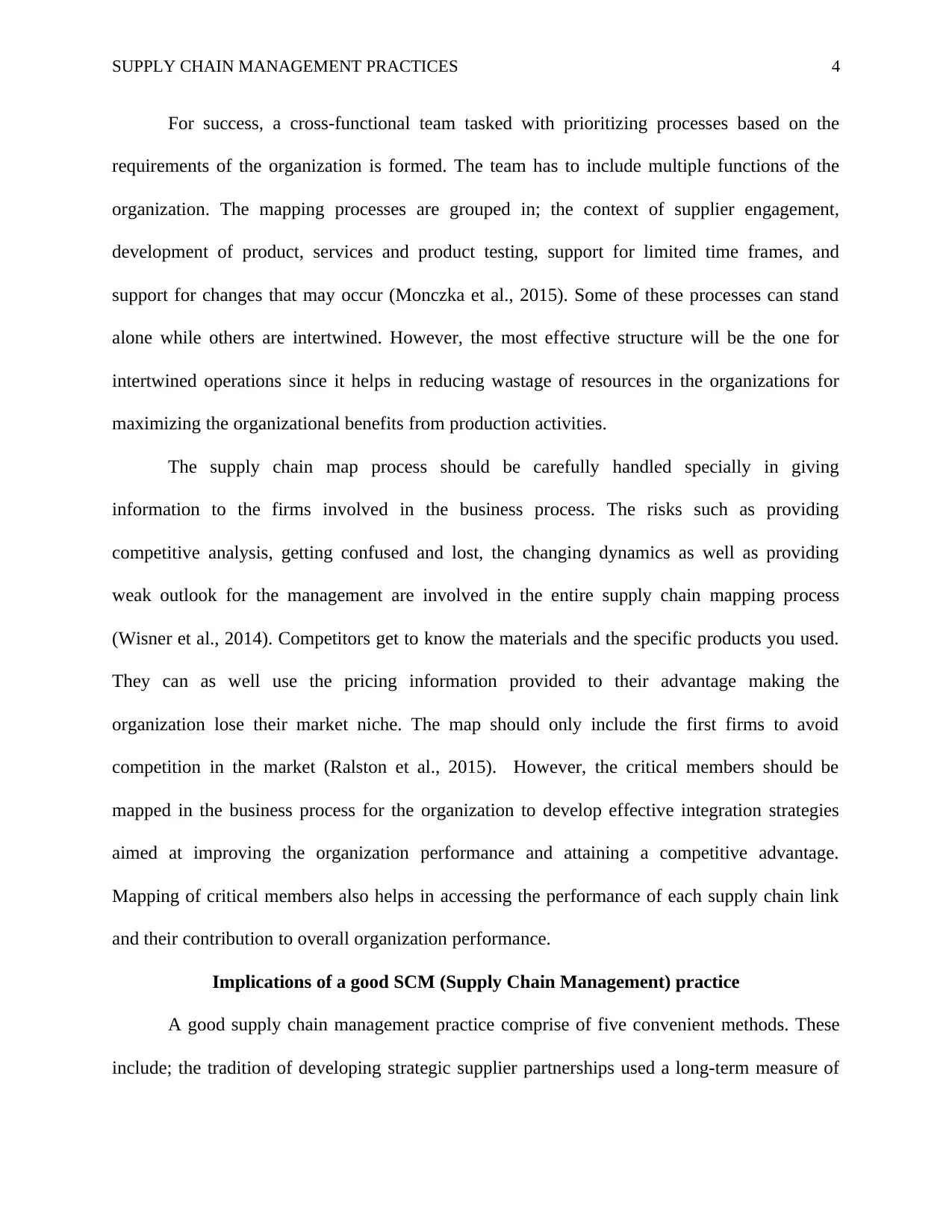
SUPPLY CHAIN MANAGEMENT PRACTICES 4
For success, a cross-functional team tasked with prioritizing processes based on the
requirements of the organization is formed. The team has to include multiple functions of the
organization. The mapping processes are grouped in; the context of supplier engagement,
development of product, services and product testing, support for limited time frames, and
support for changes that may occur (Monczka et al., 2015). Some of these processes can stand
alone while others are intertwined. However, the most effective structure will be the one for
intertwined operations since it helps in reducing wastage of resources in the organizations for
maximizing the organizational benefits from production activities.
The supply chain map process should be carefully handled specially in giving
information to the firms involved in the business process. The risks such as providing
competitive analysis, getting confused and lost, the changing dynamics as well as providing
weak outlook for the management are involved in the entire supply chain mapping process
(Wisner et al., 2014). Competitors get to know the materials and the specific products you used.
They can as well use the pricing information provided to their advantage making the
organization lose their market niche. The map should only include the first firms to avoid
competition in the market (Ralston et al., 2015). However, the critical members should be
mapped in the business process for the organization to develop effective integration strategies
aimed at improving the organization performance and attaining a competitive advantage.
Mapping of critical members also helps in accessing the performance of each supply chain link
and their contribution to overall organization performance.
Implications of a good SCM (Supply Chain Management) practice
A good supply chain management practice comprise of five convenient methods. These
include; the tradition of developing strategic supplier partnerships used a long-term measure of
For success, a cross-functional team tasked with prioritizing processes based on the
requirements of the organization is formed. The team has to include multiple functions of the
organization. The mapping processes are grouped in; the context of supplier engagement,
development of product, services and product testing, support for limited time frames, and
support for changes that may occur (Monczka et al., 2015). Some of these processes can stand
alone while others are intertwined. However, the most effective structure will be the one for
intertwined operations since it helps in reducing wastage of resources in the organizations for
maximizing the organizational benefits from production activities.
The supply chain map process should be carefully handled specially in giving
information to the firms involved in the business process. The risks such as providing
competitive analysis, getting confused and lost, the changing dynamics as well as providing
weak outlook for the management are involved in the entire supply chain mapping process
(Wisner et al., 2014). Competitors get to know the materials and the specific products you used.
They can as well use the pricing information provided to their advantage making the
organization lose their market niche. The map should only include the first firms to avoid
competition in the market (Ralston et al., 2015). However, the critical members should be
mapped in the business process for the organization to develop effective integration strategies
aimed at improving the organization performance and attaining a competitive advantage.
Mapping of critical members also helps in accessing the performance of each supply chain link
and their contribution to overall organization performance.
Implications of a good SCM (Supply Chain Management) practice
A good supply chain management practice comprise of five convenient methods. These
include; the tradition of developing strategic supplier partnerships used a long-term measure of
Paraphrase This Document
Need a fresh take? Get an instant paraphrase of this document with our AI Paraphraser
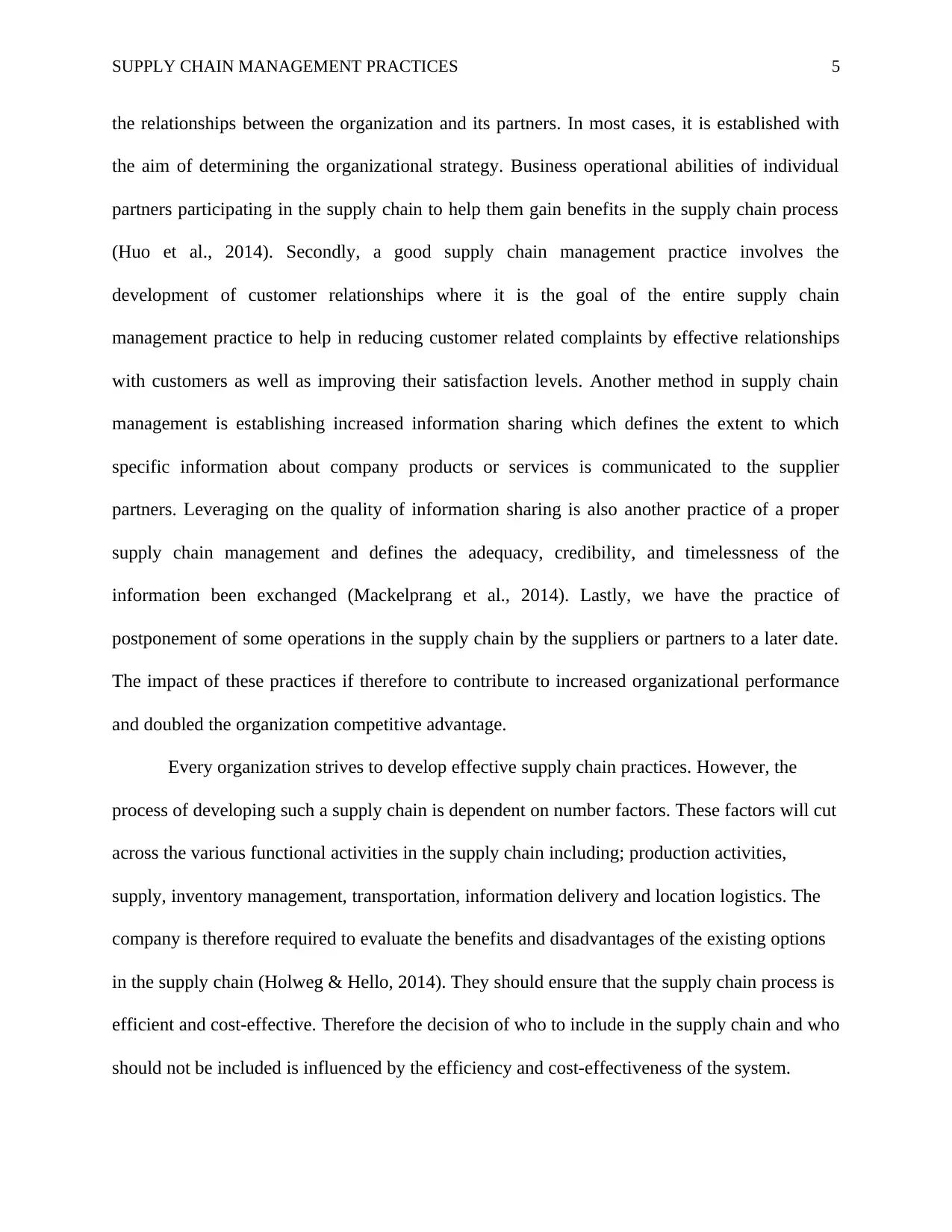
SUPPLY CHAIN MANAGEMENT PRACTICES 5
the relationships between the organization and its partners. In most cases, it is established with
the aim of determining the organizational strategy. Business operational abilities of individual
partners participating in the supply chain to help them gain benefits in the supply chain process
(Huo et al., 2014). Secondly, a good supply chain management practice involves the
development of customer relationships where it is the goal of the entire supply chain
management practice to help in reducing customer related complaints by effective relationships
with customers as well as improving their satisfaction levels. Another method in supply chain
management is establishing increased information sharing which defines the extent to which
specific information about company products or services is communicated to the supplier
partners. Leveraging on the quality of information sharing is also another practice of a proper
supply chain management and defines the adequacy, credibility, and timelessness of the
information been exchanged (Mackelprang et al., 2014). Lastly, we have the practice of
postponement of some operations in the supply chain by the suppliers or partners to a later date.
The impact of these practices if therefore to contribute to increased organizational performance
and doubled the organization competitive advantage.
Every organization strives to develop effective supply chain practices. However, the
process of developing such a supply chain is dependent on number factors. These factors will cut
across the various functional activities in the supply chain including; production activities,
supply, inventory management, transportation, information delivery and location logistics. The
company is therefore required to evaluate the benefits and disadvantages of the existing options
in the supply chain (Holweg & Hello, 2014). They should ensure that the supply chain process is
efficient and cost-effective. Therefore the decision of who to include in the supply chain and who
should not be included is influenced by the efficiency and cost-effectiveness of the system.
the relationships between the organization and its partners. In most cases, it is established with
the aim of determining the organizational strategy. Business operational abilities of individual
partners participating in the supply chain to help them gain benefits in the supply chain process
(Huo et al., 2014). Secondly, a good supply chain management practice involves the
development of customer relationships where it is the goal of the entire supply chain
management practice to help in reducing customer related complaints by effective relationships
with customers as well as improving their satisfaction levels. Another method in supply chain
management is establishing increased information sharing which defines the extent to which
specific information about company products or services is communicated to the supplier
partners. Leveraging on the quality of information sharing is also another practice of a proper
supply chain management and defines the adequacy, credibility, and timelessness of the
information been exchanged (Mackelprang et al., 2014). Lastly, we have the practice of
postponement of some operations in the supply chain by the suppliers or partners to a later date.
The impact of these practices if therefore to contribute to increased organizational performance
and doubled the organization competitive advantage.
Every organization strives to develop effective supply chain practices. However, the
process of developing such a supply chain is dependent on number factors. These factors will cut
across the various functional activities in the supply chain including; production activities,
supply, inventory management, transportation, information delivery and location logistics. The
company is therefore required to evaluate the benefits and disadvantages of the existing options
in the supply chain (Holweg & Hello, 2014). They should ensure that the supply chain process is
efficient and cost-effective. Therefore the decision of who to include in the supply chain and who
should not be included is influenced by the efficiency and cost-effectiveness of the system.
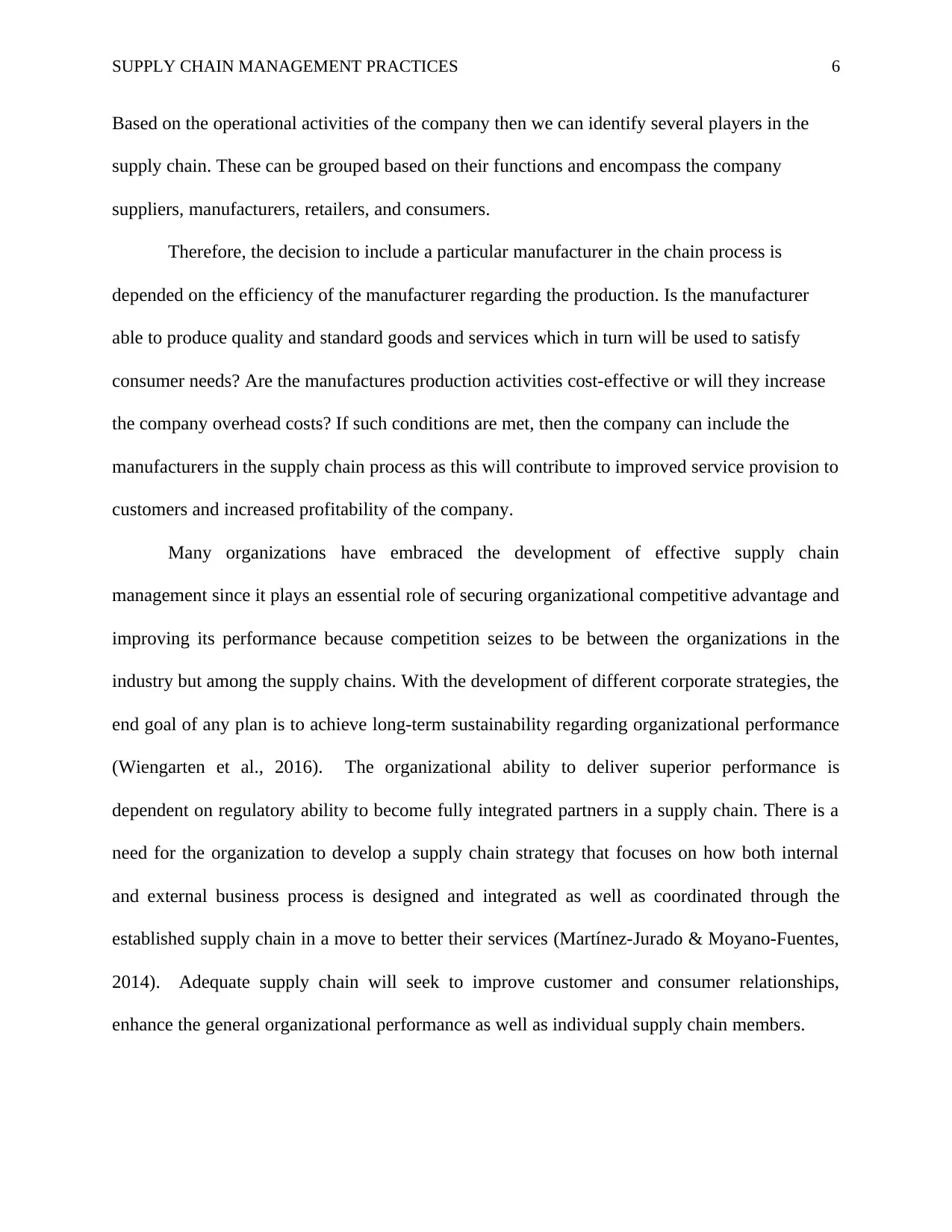
SUPPLY CHAIN MANAGEMENT PRACTICES 6
Based on the operational activities of the company then we can identify several players in the
supply chain. These can be grouped based on their functions and encompass the company
suppliers, manufacturers, retailers, and consumers.
Therefore, the decision to include a particular manufacturer in the chain process is
depended on the efficiency of the manufacturer regarding the production. Is the manufacturer
able to produce quality and standard goods and services which in turn will be used to satisfy
consumer needs? Are the manufactures production activities cost-effective or will they increase
the company overhead costs? If such conditions are met, then the company can include the
manufacturers in the supply chain process as this will contribute to improved service provision to
customers and increased profitability of the company.
Many organizations have embraced the development of effective supply chain
management since it plays an essential role of securing organizational competitive advantage and
improving its performance because competition seizes to be between the organizations in the
industry but among the supply chains. With the development of different corporate strategies, the
end goal of any plan is to achieve long-term sustainability regarding organizational performance
(Wiengarten et al., 2016). The organizational ability to deliver superior performance is
dependent on regulatory ability to become fully integrated partners in a supply chain. There is a
need for the organization to develop a supply chain strategy that focuses on how both internal
and external business process is designed and integrated as well as coordinated through the
established supply chain in a move to better their services (Martínez-Jurado & Moyano-Fuentes,
2014). Adequate supply chain will seek to improve customer and consumer relationships,
enhance the general organizational performance as well as individual supply chain members.
Based on the operational activities of the company then we can identify several players in the
supply chain. These can be grouped based on their functions and encompass the company
suppliers, manufacturers, retailers, and consumers.
Therefore, the decision to include a particular manufacturer in the chain process is
depended on the efficiency of the manufacturer regarding the production. Is the manufacturer
able to produce quality and standard goods and services which in turn will be used to satisfy
consumer needs? Are the manufactures production activities cost-effective or will they increase
the company overhead costs? If such conditions are met, then the company can include the
manufacturers in the supply chain process as this will contribute to improved service provision to
customers and increased profitability of the company.
Many organizations have embraced the development of effective supply chain
management since it plays an essential role of securing organizational competitive advantage and
improving its performance because competition seizes to be between the organizations in the
industry but among the supply chains. With the development of different corporate strategies, the
end goal of any plan is to achieve long-term sustainability regarding organizational performance
(Wiengarten et al., 2016). The organizational ability to deliver superior performance is
dependent on regulatory ability to become fully integrated partners in a supply chain. There is a
need for the organization to develop a supply chain strategy that focuses on how both internal
and external business process is designed and integrated as well as coordinated through the
established supply chain in a move to better their services (Martínez-Jurado & Moyano-Fuentes,
2014). Adequate supply chain will seek to improve customer and consumer relationships,
enhance the general organizational performance as well as individual supply chain members.
⊘ This is a preview!⊘
Do you want full access?
Subscribe today to unlock all pages.

Trusted by 1+ million students worldwide
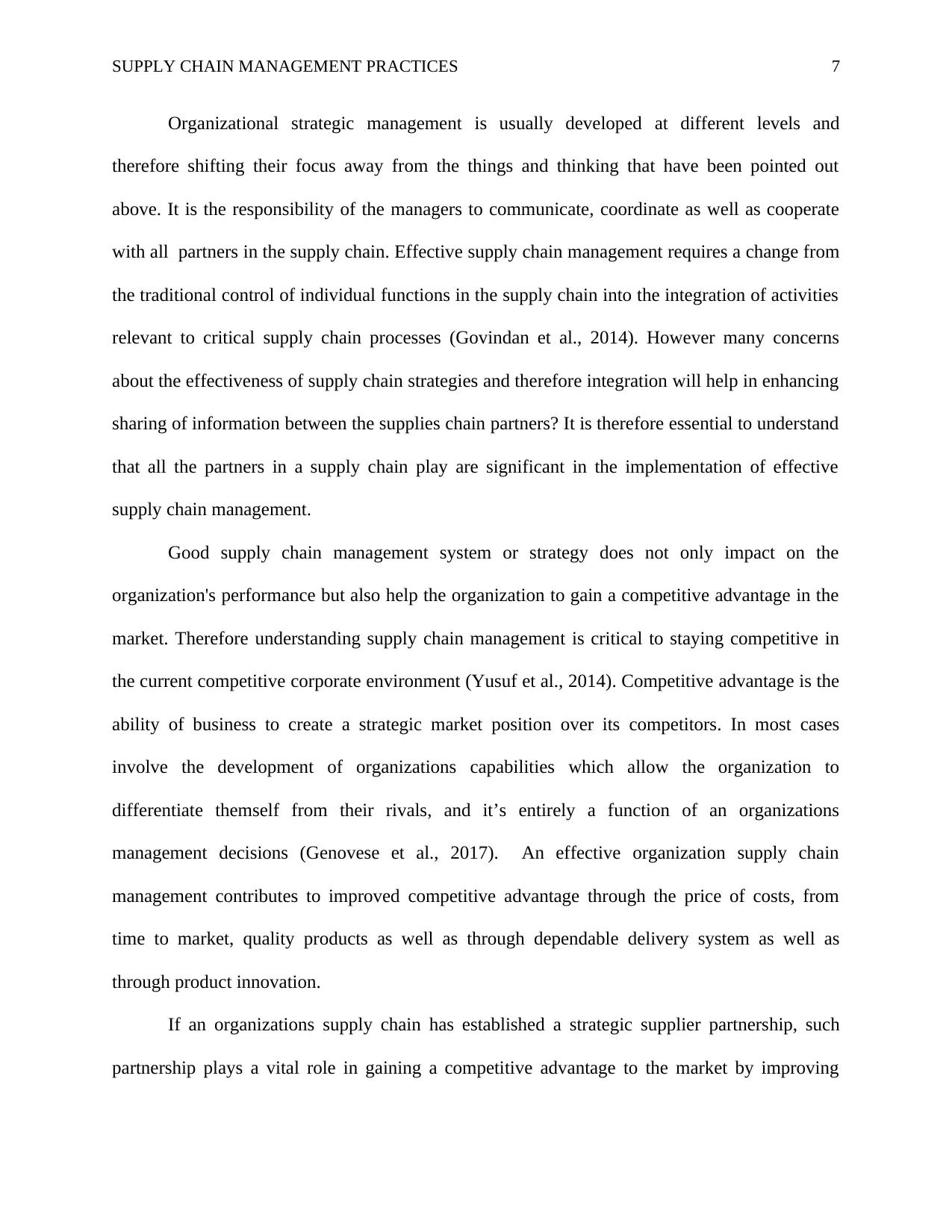
SUPPLY CHAIN MANAGEMENT PRACTICES 7
Organizational strategic management is usually developed at different levels and
therefore shifting their focus away from the things and thinking that have been pointed out
above. It is the responsibility of the managers to communicate, coordinate as well as cooperate
with all partners in the supply chain. Effective supply chain management requires a change from
the traditional control of individual functions in the supply chain into the integration of activities
relevant to critical supply chain processes (Govindan et al., 2014). However many concerns
about the effectiveness of supply chain strategies and therefore integration will help in enhancing
sharing of information between the supplies chain partners? It is therefore essential to understand
that all the partners in a supply chain play are significant in the implementation of effective
supply chain management.
Good supply chain management system or strategy does not only impact on the
organization's performance but also help the organization to gain a competitive advantage in the
market. Therefore understanding supply chain management is critical to staying competitive in
the current competitive corporate environment (Yusuf et al., 2014). Competitive advantage is the
ability of business to create a strategic market position over its competitors. In most cases
involve the development of organizations capabilities which allow the organization to
differentiate themself from their rivals, and it’s entirely a function of an organizations
management decisions (Genovese et al., 2017). An effective organization supply chain
management contributes to improved competitive advantage through the price of costs, from
time to market, quality products as well as through dependable delivery system as well as
through product innovation.
If an organizations supply chain has established a strategic supplier partnership, such
partnership plays a vital role in gaining a competitive advantage to the market by improving
Organizational strategic management is usually developed at different levels and
therefore shifting their focus away from the things and thinking that have been pointed out
above. It is the responsibility of the managers to communicate, coordinate as well as cooperate
with all partners in the supply chain. Effective supply chain management requires a change from
the traditional control of individual functions in the supply chain into the integration of activities
relevant to critical supply chain processes (Govindan et al., 2014). However many concerns
about the effectiveness of supply chain strategies and therefore integration will help in enhancing
sharing of information between the supplies chain partners? It is therefore essential to understand
that all the partners in a supply chain play are significant in the implementation of effective
supply chain management.
Good supply chain management system or strategy does not only impact on the
organization's performance but also help the organization to gain a competitive advantage in the
market. Therefore understanding supply chain management is critical to staying competitive in
the current competitive corporate environment (Yusuf et al., 2014). Competitive advantage is the
ability of business to create a strategic market position over its competitors. In most cases
involve the development of organizations capabilities which allow the organization to
differentiate themself from their rivals, and it’s entirely a function of an organizations
management decisions (Genovese et al., 2017). An effective organization supply chain
management contributes to improved competitive advantage through the price of costs, from
time to market, quality products as well as through dependable delivery system as well as
through product innovation.
If an organizations supply chain has established a strategic supplier partnership, such
partnership plays a vital role in gaining a competitive advantage to the market by improving
Paraphrase This Document
Need a fresh take? Get an instant paraphrase of this document with our AI Paraphraser
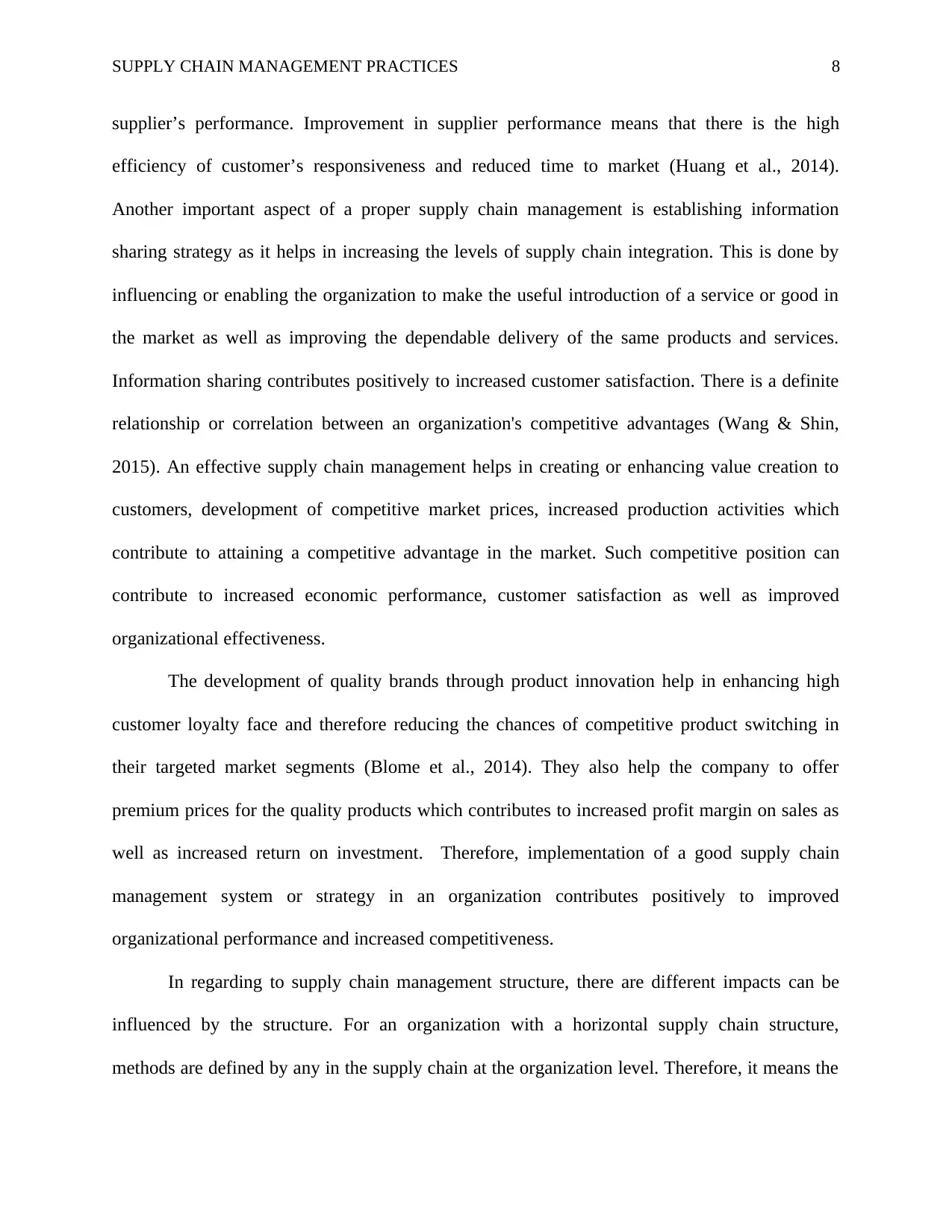
SUPPLY CHAIN MANAGEMENT PRACTICES 8
supplier’s performance. Improvement in supplier performance means that there is the high
efficiency of customer’s responsiveness and reduced time to market (Huang et al., 2014).
Another important aspect of a proper supply chain management is establishing information
sharing strategy as it helps in increasing the levels of supply chain integration. This is done by
influencing or enabling the organization to make the useful introduction of a service or good in
the market as well as improving the dependable delivery of the same products and services.
Information sharing contributes positively to increased customer satisfaction. There is a definite
relationship or correlation between an organization's competitive advantages (Wang & Shin,
2015). An effective supply chain management helps in creating or enhancing value creation to
customers, development of competitive market prices, increased production activities which
contribute to attaining a competitive advantage in the market. Such competitive position can
contribute to increased economic performance, customer satisfaction as well as improved
organizational effectiveness.
The development of quality brands through product innovation help in enhancing high
customer loyalty face and therefore reducing the chances of competitive product switching in
their targeted market segments (Blome et al., 2014). They also help the company to offer
premium prices for the quality products which contributes to increased profit margin on sales as
well as increased return on investment. Therefore, implementation of a good supply chain
management system or strategy in an organization contributes positively to improved
organizational performance and increased competitiveness.
In regarding to supply chain management structure, there are different impacts can be
influenced by the structure. For an organization with a horizontal supply chain structure,
methods are defined by any in the supply chain at the organization level. Therefore, it means the
supplier’s performance. Improvement in supplier performance means that there is the high
efficiency of customer’s responsiveness and reduced time to market (Huang et al., 2014).
Another important aspect of a proper supply chain management is establishing information
sharing strategy as it helps in increasing the levels of supply chain integration. This is done by
influencing or enabling the organization to make the useful introduction of a service or good in
the market as well as improving the dependable delivery of the same products and services.
Information sharing contributes positively to increased customer satisfaction. There is a definite
relationship or correlation between an organization's competitive advantages (Wang & Shin,
2015). An effective supply chain management helps in creating or enhancing value creation to
customers, development of competitive market prices, increased production activities which
contribute to attaining a competitive advantage in the market. Such competitive position can
contribute to increased economic performance, customer satisfaction as well as improved
organizational effectiveness.
The development of quality brands through product innovation help in enhancing high
customer loyalty face and therefore reducing the chances of competitive product switching in
their targeted market segments (Blome et al., 2014). They also help the company to offer
premium prices for the quality products which contributes to increased profit margin on sales as
well as increased return on investment. Therefore, implementation of a good supply chain
management system or strategy in an organization contributes positively to improved
organizational performance and increased competitiveness.
In regarding to supply chain management structure, there are different impacts can be
influenced by the structure. For an organization with a horizontal supply chain structure,
methods are defined by any in the supply chain at the organization level. Therefore, it means the
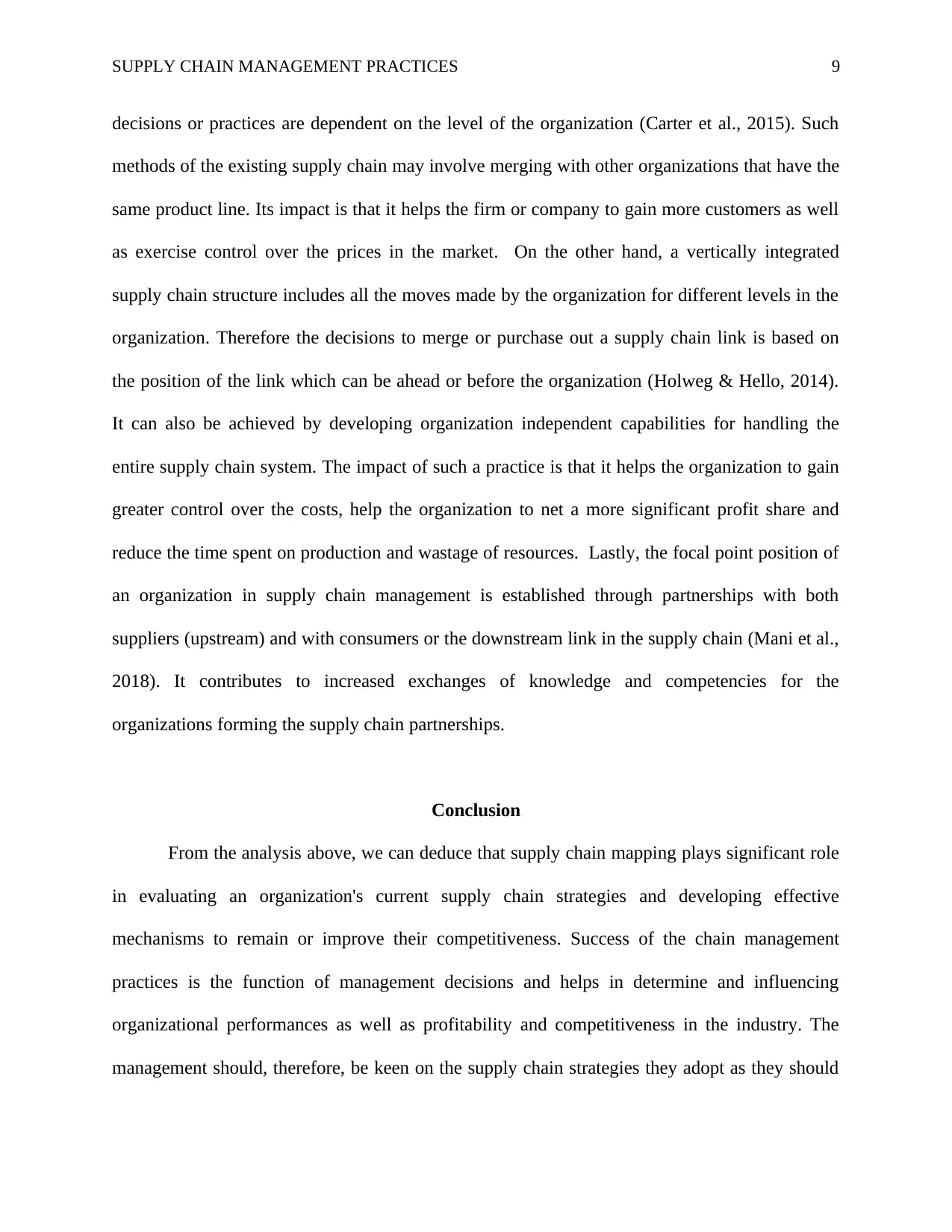
SUPPLY CHAIN MANAGEMENT PRACTICES 9
decisions or practices are dependent on the level of the organization (Carter et al., 2015). Such
methods of the existing supply chain may involve merging with other organizations that have the
same product line. Its impact is that it helps the firm or company to gain more customers as well
as exercise control over the prices in the market. On the other hand, a vertically integrated
supply chain structure includes all the moves made by the organization for different levels in the
organization. Therefore the decisions to merge or purchase out a supply chain link is based on
the position of the link which can be ahead or before the organization (Holweg & Hello, 2014).
It can also be achieved by developing organization independent capabilities for handling the
entire supply chain system. The impact of such a practice is that it helps the organization to gain
greater control over the costs, help the organization to net a more significant profit share and
reduce the time spent on production and wastage of resources. Lastly, the focal point position of
an organization in supply chain management is established through partnerships with both
suppliers (upstream) and with consumers or the downstream link in the supply chain (Mani et al.,
2018). It contributes to increased exchanges of knowledge and competencies for the
organizations forming the supply chain partnerships.
Conclusion
From the analysis above, we can deduce that supply chain mapping plays significant role
in evaluating an organization's current supply chain strategies and developing effective
mechanisms to remain or improve their competitiveness. Success of the chain management
practices is the function of management decisions and helps in determine and influencing
organizational performances as well as profitability and competitiveness in the industry. The
management should, therefore, be keen on the supply chain strategies they adopt as they should
decisions or practices are dependent on the level of the organization (Carter et al., 2015). Such
methods of the existing supply chain may involve merging with other organizations that have the
same product line. Its impact is that it helps the firm or company to gain more customers as well
as exercise control over the prices in the market. On the other hand, a vertically integrated
supply chain structure includes all the moves made by the organization for different levels in the
organization. Therefore the decisions to merge or purchase out a supply chain link is based on
the position of the link which can be ahead or before the organization (Holweg & Hello, 2014).
It can also be achieved by developing organization independent capabilities for handling the
entire supply chain system. The impact of such a practice is that it helps the organization to gain
greater control over the costs, help the organization to net a more significant profit share and
reduce the time spent on production and wastage of resources. Lastly, the focal point position of
an organization in supply chain management is established through partnerships with both
suppliers (upstream) and with consumers or the downstream link in the supply chain (Mani et al.,
2018). It contributes to increased exchanges of knowledge and competencies for the
organizations forming the supply chain partnerships.
Conclusion
From the analysis above, we can deduce that supply chain mapping plays significant role
in evaluating an organization's current supply chain strategies and developing effective
mechanisms to remain or improve their competitiveness. Success of the chain management
practices is the function of management decisions and helps in determine and influencing
organizational performances as well as profitability and competitiveness in the industry. The
management should, therefore, be keen on the supply chain strategies they adopt as they should
⊘ This is a preview!⊘
Do you want full access?
Subscribe today to unlock all pages.

Trusted by 1+ million students worldwide

SUPPLY CHAIN MANAGEMENT PRACTICES 10
be aimed at improving or developing the organization's capabilities. The end goal of an adequate
supply chain mapping and supply chain management practices is to contribute to increased
consumer satisfaction by managing consumer complaints and also helping to increased
organization profitability and gaining a competitive advantage in the industry.
be aimed at improving or developing the organization's capabilities. The end goal of an adequate
supply chain mapping and supply chain management practices is to contribute to increased
consumer satisfaction by managing consumer complaints and also helping to increased
organization profitability and gaining a competitive advantage in the industry.
Paraphrase This Document
Need a fresh take? Get an instant paraphrase of this document with our AI Paraphraser
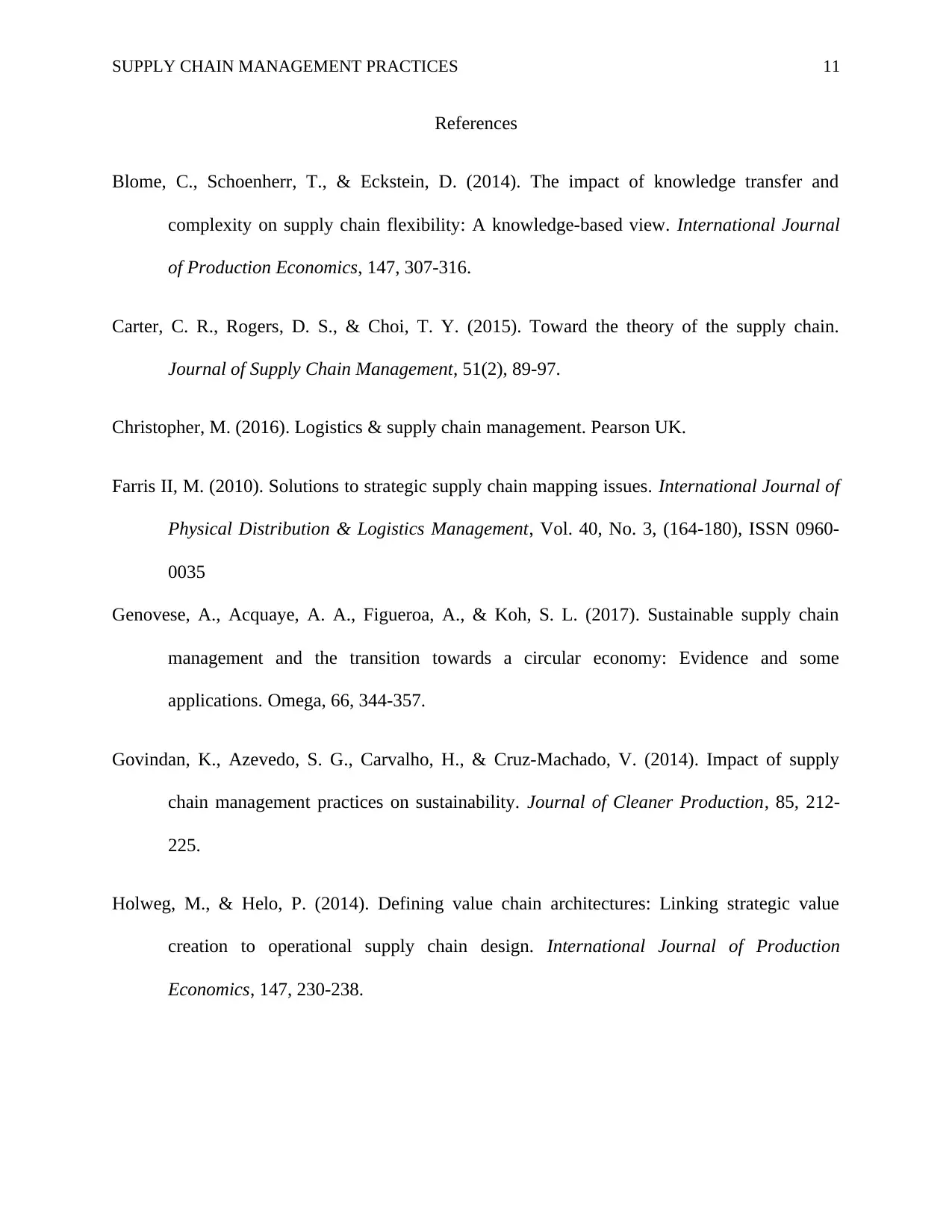
SUPPLY CHAIN MANAGEMENT PRACTICES 11
References
Blome, C., Schoenherr, T., & Eckstein, D. (2014). The impact of knowledge transfer and
complexity on supply chain flexibility: A knowledge-based view. International Journal
of Production Economics, 147, 307-316.
Carter, C. R., Rogers, D. S., & Choi, T. Y. (2015). Toward the theory of the supply chain.
Journal of Supply Chain Management, 51(2), 89-97.
Christopher, M. (2016). Logistics & supply chain management. Pearson UK.
Farris II, M. (2010). Solutions to strategic supply chain mapping issues. International Journal of
Physical Distribution & Logistics Management, Vol. 40, No. 3, (164-180), ISSN 0960-
0035
Genovese, A., Acquaye, A. A., Figueroa, A., & Koh, S. L. (2017). Sustainable supply chain
management and the transition towards a circular economy: Evidence and some
applications. Omega, 66, 344-357.
Govindan, K., Azevedo, S. G., Carvalho, H., & Cruz-Machado, V. (2014). Impact of supply
chain management practices on sustainability. Journal of Cleaner Production, 85, 212-
225.
Holweg, M., & Helo, P. (2014). Defining value chain architectures: Linking strategic value
creation to operational supply chain design. International Journal of Production
Economics, 147, 230-238.
References
Blome, C., Schoenherr, T., & Eckstein, D. (2014). The impact of knowledge transfer and
complexity on supply chain flexibility: A knowledge-based view. International Journal
of Production Economics, 147, 307-316.
Carter, C. R., Rogers, D. S., & Choi, T. Y. (2015). Toward the theory of the supply chain.
Journal of Supply Chain Management, 51(2), 89-97.
Christopher, M. (2016). Logistics & supply chain management. Pearson UK.
Farris II, M. (2010). Solutions to strategic supply chain mapping issues. International Journal of
Physical Distribution & Logistics Management, Vol. 40, No. 3, (164-180), ISSN 0960-
0035
Genovese, A., Acquaye, A. A., Figueroa, A., & Koh, S. L. (2017). Sustainable supply chain
management and the transition towards a circular economy: Evidence and some
applications. Omega, 66, 344-357.
Govindan, K., Azevedo, S. G., Carvalho, H., & Cruz-Machado, V. (2014). Impact of supply
chain management practices on sustainability. Journal of Cleaner Production, 85, 212-
225.
Holweg, M., & Helo, P. (2014). Defining value chain architectures: Linking strategic value
creation to operational supply chain design. International Journal of Production
Economics, 147, 230-238.
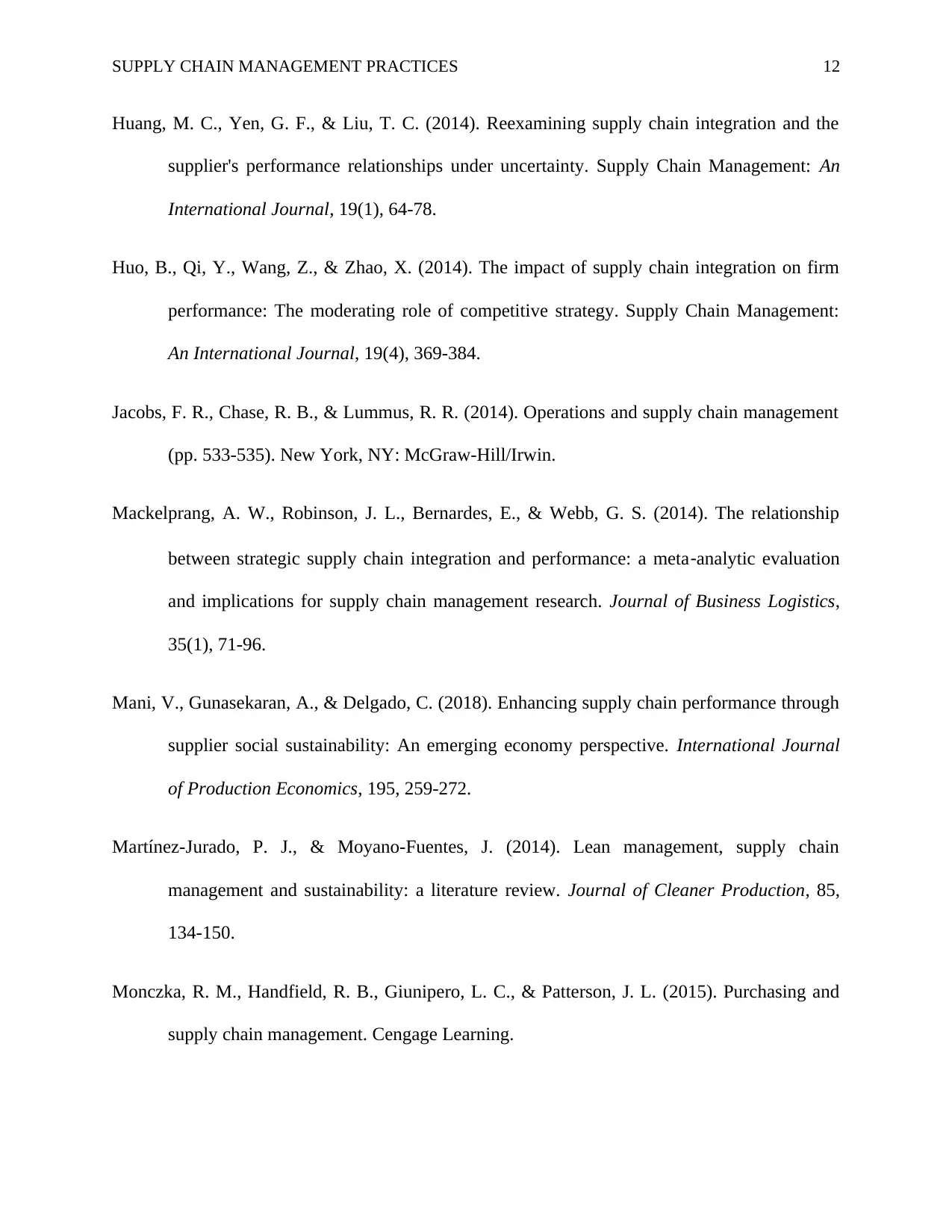
SUPPLY CHAIN MANAGEMENT PRACTICES 12
Huang, M. C., Yen, G. F., & Liu, T. C. (2014). Reexamining supply chain integration and the
supplier's performance relationships under uncertainty. Supply Chain Management: An
International Journal, 19(1), 64-78.
Huo, B., Qi, Y., Wang, Z., & Zhao, X. (2014). The impact of supply chain integration on firm
performance: The moderating role of competitive strategy. Supply Chain Management:
An International Journal, 19(4), 369-384.
Jacobs, F. R., Chase, R. B., & Lummus, R. R. (2014). Operations and supply chain management
(pp. 533-535). New York, NY: McGraw-Hill/Irwin.
Mackelprang, A. W., Robinson, J. L., Bernardes, E., & Webb, G. S. (2014). The relationship
between strategic supply chain integration and performance: a meta‐analytic evaluation
and implications for supply chain management research. Journal of Business Logistics,
35(1), 71-96.
Mani, V., Gunasekaran, A., & Delgado, C. (2018). Enhancing supply chain performance through
supplier social sustainability: An emerging economy perspective. International Journal
of Production Economics, 195, 259-272.
Martínez-Jurado, P. J., & Moyano-Fuentes, J. (2014). Lean management, supply chain
management and sustainability: a literature review. Journal of Cleaner Production, 85,
134-150.
Monczka, R. M., Handfield, R. B., Giunipero, L. C., & Patterson, J. L. (2015). Purchasing and
supply chain management. Cengage Learning.
Huang, M. C., Yen, G. F., & Liu, T. C. (2014). Reexamining supply chain integration and the
supplier's performance relationships under uncertainty. Supply Chain Management: An
International Journal, 19(1), 64-78.
Huo, B., Qi, Y., Wang, Z., & Zhao, X. (2014). The impact of supply chain integration on firm
performance: The moderating role of competitive strategy. Supply Chain Management:
An International Journal, 19(4), 369-384.
Jacobs, F. R., Chase, R. B., & Lummus, R. R. (2014). Operations and supply chain management
(pp. 533-535). New York, NY: McGraw-Hill/Irwin.
Mackelprang, A. W., Robinson, J. L., Bernardes, E., & Webb, G. S. (2014). The relationship
between strategic supply chain integration and performance: a meta‐analytic evaluation
and implications for supply chain management research. Journal of Business Logistics,
35(1), 71-96.
Mani, V., Gunasekaran, A., & Delgado, C. (2018). Enhancing supply chain performance through
supplier social sustainability: An emerging economy perspective. International Journal
of Production Economics, 195, 259-272.
Martínez-Jurado, P. J., & Moyano-Fuentes, J. (2014). Lean management, supply chain
management and sustainability: a literature review. Journal of Cleaner Production, 85,
134-150.
Monczka, R. M., Handfield, R. B., Giunipero, L. C., & Patterson, J. L. (2015). Purchasing and
supply chain management. Cengage Learning.
⊘ This is a preview!⊘
Do you want full access?
Subscribe today to unlock all pages.

Trusted by 1+ million students worldwide
1 out of 13
Related Documents
Your All-in-One AI-Powered Toolkit for Academic Success.
+13062052269
info@desklib.com
Available 24*7 on WhatsApp / Email
![[object Object]](/_next/static/media/star-bottom.7253800d.svg)
Unlock your academic potential
Copyright © 2020–2025 A2Z Services. All Rights Reserved. Developed and managed by ZUCOL.




